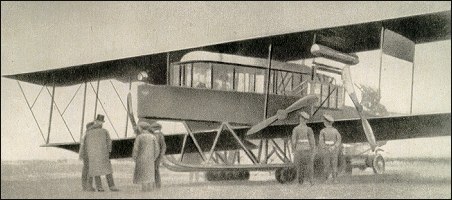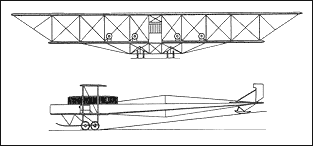|
| Following his first unsuccessful experiments with rotary-wing aircraft in 1909-10, the Russian Igor Sikorsky concentrated upon design and development of fixed-wing aircraft. His Sikorsky S-1 to S-5 wer e little more than experimental types, but with the S-2 biplane he achieved a first 12-second hop in 1910. Growing experience and capability gained him an appointment in 1912 as designer and chief engineer of the Russo-Baltic Wagon Works (RBVZ) and he at once became involved in design and construction of the world's first four-engined aircraft, named officially Russkii Vitiaz (Russian knight) . Its 28.00m wing span earned it the nickname 'Le Grand'. Four 75kW Argus inline engines were mounted on the lower wings and it was with this powerplant, and piloted by Sikorsky, that the type was flown for the first time on 13 May 1913. On 2 August 1913 it was airborne for 1 hour 54 minutes with eight people aboard and had recorded 53 almost trouble-free flights before it was dismantled after being damaged on the ground.
| CREW | 2 |
| PASSENGERS | 6 |
| ENGINE | 4 x Argus, 72kW |
| WEIGHTS |
| Take-off weight | 4200 kg | 9259 lb |
| Empty weight | 3500 kg | 7716 lb |
| DIMENSIONS |
| Wingspan | 27.0/20.0 m | 89 ft 7 in / 66 ft 7 in |
| Length | 20.0 m | 66 ft 7 in |
| Wing area | 120.0 m2 | 1291.67 sq ft |
| PERFORMANCE |
| Max. speed | 90 km/h | 56 mph |
| Klaatu83, e-mail, 20.04.2015 15:59 "Sikorsky somehow knew intuitively that high-aspect-ratio wings (i.e., long and slender) were more efficient than shorter span wings of the same area. How did he know this"
Have you ever seen the wings on a seagull or an albatross? reply | | michael salkind, e-mail, 28.06.2011 18:52 When I worked with Igor Sikorsky at Sikorsky Aircraft in 1968, he told me that the reason this aircraft looks more like a boat than an airplane in front is that the Director of the Russo-Baltic Wagon Works was a former Navy Captain and he designed it that way to get his boss's acceptance. reply | | choqing, 20.06.2011 05:23 Sikorsky somehow knew intuitively that high-aspect-ratio wings (i.e., long and slender) were more efficient than shorter span wings of the same area. How did he know this reply | | John W Juechter, e-mail, 08.01.2009 00:12 I've been building a model of the Sikorsky Grand for some 6 years now. The original plane went through 3 main configurations: 2 engines; 4 engines, 2 tractor, 2 pusher; and 4 tractor engines. In its last configuration, it also had 4 rudders and 16 wheels. Most artist's paintings do not show the plane correctly, presenting a combination of the various configurations. In fact, the model of the Grand at Sikorsky Headquarters in Stratford is wrong, purporting to show the 4-engine configuration, but with only 2 rudders. reply | |
| | Jay Spenser, e-mail, 28.07.2007 23:33 The Grande, and the Ilya Muromets bombers it inspired, were far beyond the rest of the world in terms of size and capability. One of the most remarkable features of this airplane is its very long wings. Before wing theory was generally understood, Sikorsky somehow knew intuitively that high-aspect-ratio wings (i.e., long and slender) were more efficient than shorter span wings of the same area. How did he know this? reply | | Luis M- Moreno, e-mail, 18.02.2007 13:24 Es importante dar a conocer los avances que la aviciуn tuvo gracias a Igor Sikorsky en sus primeros tiempos.
El S-21 Russki Vityaz fuй una muestra de lo avanzada que estaba Rusia en el campo de la aeronбutica ya entonces, demostrando que los grandes aparatos "mбs pesados que el aire" serian imprescindibles para el desarroyo de la humanidad. reply |
|
Do you have any comments?
|
| 
COMPANY
PROFILE
All the World's Rotorcraft
|







